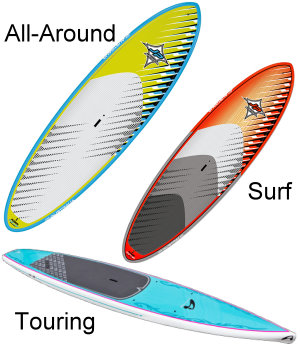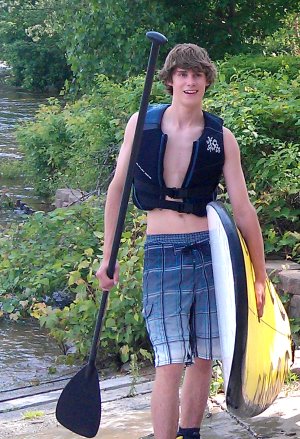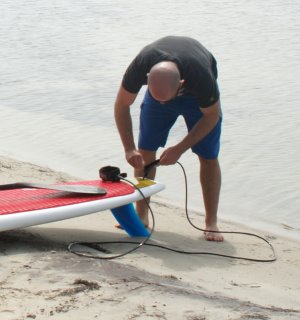Getting Started In Stand Up Paddleboarding - Part 1
Getting Started In Stand Up Paddleboarding (SUP)
by Kim Evans
Part 1
It is summertime and you have been watching people out on stand up paddle boards, perhaps taken a lesson, and are ready to purchase the equipment needed to be out on the water. The question you then ask yourself is, what do you need to get started? The good news is: not much. To get out paddling right away you only need four things; a board, a paddle, a personal flotation device (PFD), and a board leash. Let's break it down...
The Board
 The type of paddle board you get will depend largely on where and how you will be using it. Will you be on an inland lake? How about Lake Michigan? Is it for fun, for fitness, for surf? Will it be your personal board, or will you be sharing it?
The type of paddle board you get will depend largely on where and how you will be using it. Will you be on an inland lake? How about Lake Michigan? Is it for fun, for fitness, for surf? Will it be your personal board, or will you be sharing it?
An all-around board is a great choice if you will be stand up paddling both inland and the big lake. These boards are designed for mostly flat conditions, but can handle smaller waves. They look like a large surfboard, with the same long oval shape.
A touring board resembles a kayak with the top cut off, with the long pointed nose to cut through the water in a straight line. This board is an excellent SUP if you want to paddle for fitness or want to make a pass at the paddleboard racing circuit.
If you are going to go out and try your hand at paddle surfing, there are surf-specific paddleboards designed to ride the waves. These tend to be shorter in length to be more manageable in the waves, and have more rocker for greater surf performance.
Almost any type of board will go from one place to another, but you should get the board that works best in the place you will be using it the most. If more than one person will be using your board, make sure it can handle the weight of the larger person. When children (or dogs) are on the board you need to consider their extra weight, as well as their instability, since neither sits still for long! If you can store your board out of the elements, get a composite board, such as a JP Australia. These boards are lightweight and come in all of the different options, but require just a bit more care to keep them looking and handling well. If the board is going to sit on your beach, get dragged in and out of the water or used by multiple people, molded plastic would be the better choice. Companies like Bic make some excellent plastic boards that perform amazingly well, as good as their higher priced composite boards.
I f you will be using your board at least a couple of times each week, I would advise against buying strictly a beginner board. You will quickly find that board to be too easy for your growing skills. Get a board that is challenging; one that is not quite as stable and makes you feel like you are really using your paddling talent. You should also pick up the board and see how you handle it by yourself. A lightweight board that is easy to handle and transport is going to be used more often than one that requires assistance.
f you will be using your board at least a couple of times each week, I would advise against buying strictly a beginner board. You will quickly find that board to be too easy for your growing skills. Get a board that is challenging; one that is not quite as stable and makes you feel like you are really using your paddling talent. You should also pick up the board and see how you handle it by yourself. A lightweight board that is easy to handle and transport is going to be used more often than one that requires assistance.
The Paddle
Again, if more than one person is using the board, an adjustable length paddle is a must. These paddles can easily be adjusted to different heights for each person. Try the paddle out; the handle should fit comfortably in your hand. As a general rule, the lighter the paddle is, the better. You will appreciate the lighter weight the more you paddle. If the paddle board is yours alone, a fixed length paddle is what you want. These paddles are custom cut for your specific height and will have less flex due to being a single cut.
The Personal Flotation Device (PFD)
This is your most important piece of equipment. The US Coast Guard has deemed SUPs as vessels, and all vessels must have PFDs on board. If at all possible, you should wear your PFD. There are great options that look like a fanny pack; they can be quickly inflated by pulling the rip cord and activating the CO2 cartridge. Think of it as an airbag for YOU! You can also wear a vest PFD, but be sure to try paddling in it to make sure it is comfortable. If you are not wearing it, it needs to be strapped on top of your board while you are paddling.
The Leash
 The leash is what keeps you attached to the board, one end strapped to the tail of the board, and the other end attached to you. This is not as vital in inland waters, but on the big lake or in waves you will want to keep your board nearby should you fall off. The board will easily go all the way to shore on top of a wave without you, leaving you with a long schlogg in.(Been there, done that, and gone up to my car to get my leash promptly afterwards!) There are two types of leashes, one coiled and one straight. Big lake paddlers will want a more traditional straight leash; it keeps the board further away from you in waves. Inland paddles can use a coiled leash as you merely fall off the board and don't need to chase it.
The leash is what keeps you attached to the board, one end strapped to the tail of the board, and the other end attached to you. This is not as vital in inland waters, but on the big lake or in waves you will want to keep your board nearby should you fall off. The board will easily go all the way to shore on top of a wave without you, leaving you with a long schlogg in.(Been there, done that, and gone up to my car to get my leash promptly afterwards!) There are two types of leashes, one coiled and one straight. Big lake paddlers will want a more traditional straight leash; it keeps the board further away from you in waves. Inland paddles can use a coiled leash as you merely fall off the board and don't need to chase it.
When you are paddling, you should either be wearing your PFD, or have the leash attached to you. It does you no good at all to fall off of your SUP with the PFD sitting on the board, which is now out of your reach. If you are at the least wearing the leash you will be able to easily get back to the board, as it cannot get away from you. Safety first!
Those are the four things you need to get started. MACkite has an experienced and knowledgeable sales staff to help you figure out what type of equipment is best for you. Take a demo lesson with the Crew and try out all of the different boards...the JPs, BICs, Imagines. See you on the water!
